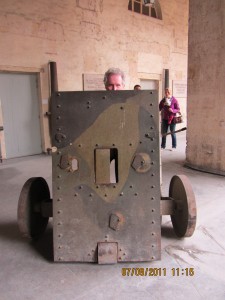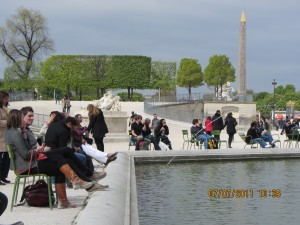
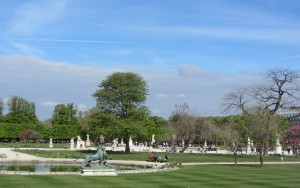 A 12 year old could throw a stone across the Seine at Notre Dame Cathedral, but whether wide or narrow, it is the heart of Paris, and the bridges that cross it the best places to take in that muted northern-yellow Paris light that so complements the color of the apartment buildings. This early in the morning, under a hazy gray blue cloud cover, the city achieves a pale luminosity.
A 12 year old could throw a stone across the Seine at Notre Dame Cathedral, but whether wide or narrow, it is the heart of Paris, and the bridges that cross it the best places to take in that muted northern-yellow Paris light that so complements the color of the apartment buildings. This early in the morning, under a hazy gray blue cloud cover, the city achieves a pale luminosity.
In New York City, unless you visit Central Park or the Battery, you see so little of the sky that it becomes a lost feature of a landscape made of concrete, granite and glass. Here, because of the Seine and the long strands of the Boulevards and the limited height of the buildings, the sky becomes a force of character.
(Double click on the photos for larger, clearer images)
Much later in the day I watch crowds walking along the Quai to the south on the Left Bank browsing the long line of book seller’s stalls. Tourist barges pass by. In just a few minutes loitering on the Pont Saint-Louis I hear English, Italian, German, Spanish, Chinese, Russian, Arabic and at least two Slavic languages I cannot identify. Traffic on the Rue de Rivoli is heavy, but I know that a warren of small side streets sit just behind the traffic and the blocks of apartments. For me Paris is composed of the grand public spaces like the Jardin de Tuilleries and equally so of narrow streets stocked with chocolatiers, fruitieres, poissonneries, boucheries, shoe and dress shops, storefronts filled with antiques and porcelain, and restaurants and small hotels. Paris is the Seine and its bridges, the Metro, the museums, and the cafes, always the cafes.
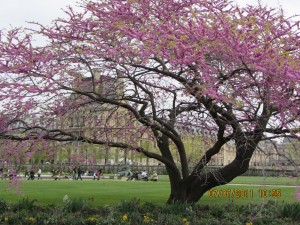
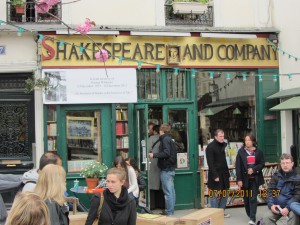 Sitting in only one of many cafes we visited, this time in Saint Germain, I understood why they survive, the café au lait and the croissant aside — everyone turns their chairs to face outward, into the flow of walkers. You may half turn your body or head to speak to your friend, but you make sure that you do not lose sight of the crowds surging past you. Sitting, eyes below their eyes, you have a kind of permission to boldly look at everyone, to wander the flow or to examine one person. City dwellers must have been doing this since Ur. Paris has retained its human scale.
Sitting in only one of many cafes we visited, this time in Saint Germain, I understood why they survive, the café au lait and the croissant aside — everyone turns their chairs to face outward, into the flow of walkers. You may half turn your body or head to speak to your friend, but you make sure that you do not lose sight of the crowds surging past you. Sitting, eyes below their eyes, you have a kind of permission to boldly look at everyone, to wander the flow or to examine one person. City dwellers must have been doing this since Ur. Paris has retained its human scale.
We walked 10 miles each of the five days we spent in Paris — along the Rue de l’Universite to the Eiffel Tower, to the Hotel Invalides, through long swathes of Montmartre, through the Louvre and all of the Tuilleries; we circled Saint Germain and followed the Rue Saint-Honore.
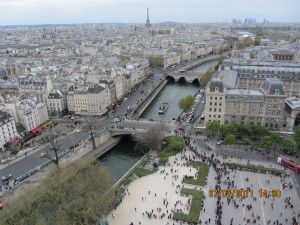
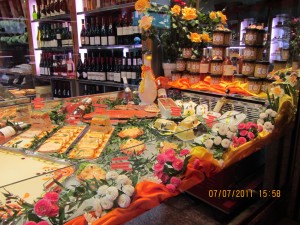 Clouds of rooks circled the park just outside the central courtyard of the Louvre at the same time I saw a peculiar little man in a threadbare suit coat and dress shoes begin a short-stepping run toward the Place de la Concorde. He kept a fast pace for several hundred yards. For a moment I thought the rooks were descending upon him. A few minutes later I watched two laughing friends exchange a double hand slap and heart thump, a greeting I’d never seen.
Clouds of rooks circled the park just outside the central courtyard of the Louvre at the same time I saw a peculiar little man in a threadbare suit coat and dress shoes begin a short-stepping run toward the Place de la Concorde. He kept a fast pace for several hundred yards. For a moment I thought the rooks were descending upon him. A few minutes later I watched two laughing friends exchange a double hand slap and heart thump, a greeting I’d never seen.
Three unsmiling soldiers in dark berets, camo dress and paratrooper boots walked past us the line waiting to enter the Louvre, their heads in motion, their automatic weapons angled low.
Smiling men and women in casual dress and black armbands that read Securite pedaled slowly along the crushed stone paths of the Tuilleries. Clusters of children and families and couples sat at the great circular fountain in green chairs, their feet propped on the lip, talking, reading, and meditating. Here, as at cafes, you can watch others freely, indulging curiosity, happy to be among so many at their ease.
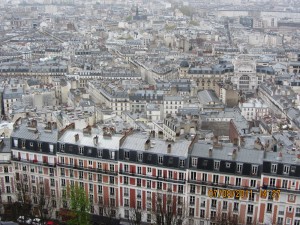
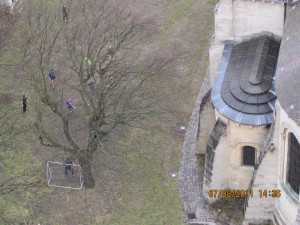
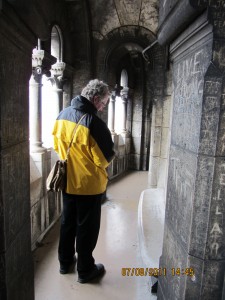 French police come in at least two guises. Men and women in blue from ankle to head jogged up steps and walked among the crowds — blue shirts, trousers, baseball caps and even flak jackets. The motorcycle officers wear white leather holsters and white helmets, blue uniforms and high leather boots. They all look fit.
French police come in at least two guises. Men and women in blue from ankle to head jogged up steps and walked among the crowds — blue shirts, trousers, baseball caps and even flak jackets. The motorcycle officers wear white leather holsters and white helmets, blue uniforms and high leather boots. They all look fit.
We took the Metro to Montmartre and emerged in the Place Pigalle, a mixed street of porn theaters, strip joints, cafes which spilled out rough looking men, tourists everywhere and graffiti that grew in volume and intensity; I saw this first: ils ont pris nos emplois; they took our jobs.
We climbed the Rue des Martyrs. Elegant apartments filled the side streets. They mixed with the dirtier, closed in sections. The graffiti grew worse the higher we ascended.
The Sacre de Cour, a large white domed church rests atop the highest point in Paris, the butte of Montmartre. In the rain and low clouds of the day we visited, apartment blocks below us formed U’s and curls. The banlieues rose up in rectangles to the southeast. Umbrellas of all colors choked the streets.
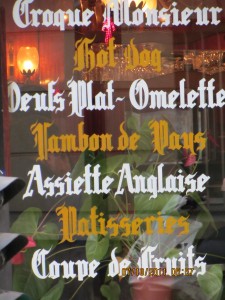
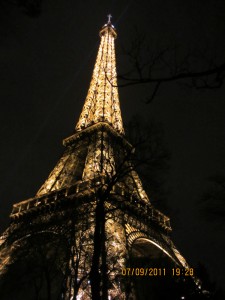 We climbed the circular stair case to the top and escaped the crowds in the Basilica. More graffiti:
We climbed the circular stair case to the top and escaped the crowds in the Basilica. More graffiti:
Melody Lao, USA, South Bend Ind, 7-23-2003
Peafi and Delpha
Mustapha and Anne
Justice, J.L., 1970
Broud and Trecbeca — Love is Us
And my favorite:
Pour Mein Amour, la plus Belle, ma bichette, Je taime!
I found this graffiti heartening. It reminded me of how right Beckett was in Waiting For Godot: Estragon: We always find something, eh Didi, to give us the impression we exist? Vladimir: Yes, yes, we’re magicians.”
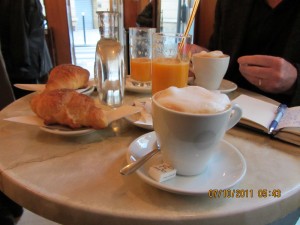
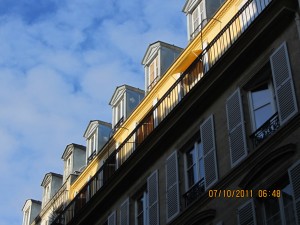 Unlike the Bell Tower at Notre Dame, there is no suicide cage here. I can lean out and look down. I count twelve young men and boys playing soccer in the green courtyard of a church. Some of the roofs look cast out of silver.
Unlike the Bell Tower at Notre Dame, there is no suicide cage here. I can lean out and look down. I count twelve young men and boys playing soccer in the green courtyard of a church. Some of the roofs look cast out of silver.
Coming down the hill we took a steep, looping staircase bounded by bare rock through heavy trees and flowering shrubs. Birds everywhere. It also smelled of piss. This too is Paris.
We took our best meal in an Italian restaurant. Looking for a recommended French bistro that turned out to be closed, we lucked into the tiny Ristorante Casta d’Amalfi * on the Rue de l‘Universite. Its electric blue sign drew us in.
I am no gourmet, but oh my, this meal…. Pasta stuffed with ricotta and spinach in a sauce I would have licked off the plate if I had been alone. A light Sicilian wine. The best lemon curd, lemon anything, I have ever eaten and all of it finished with Limoncello poured gratis by the owner and host, Maximilian, a late 30’s Sicilian who spoke French, English and Chinese and whose warmth and sly humor gave his food a perfect harmony.
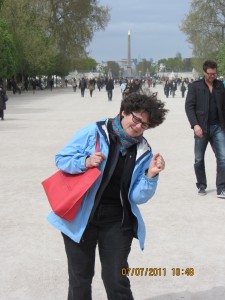 On our final night we walked to the Eiffel Tower and stood in crowds of French high school kids clowning with their teachers for photos. We were all laughing. The Tower, lit from tip to base, had a hallucinatory quality, as if it should belong to all great cities, the elegant, slim accompaniment of a still fresh modernity.
On our final night we walked to the Eiffel Tower and stood in crowds of French high school kids clowning with their teachers for photos. We were all laughing. The Tower, lit from tip to base, had a hallucinatory quality, as if it should belong to all great cities, the elegant, slim accompaniment of a still fresh modernity.
On the morning we left our hotel for the shuttle to the airport, a bright cloudless sky above the quiet street, the sun lit the top stories of the apartments around us. We drove through an awakening city, its windows thrown open to that sun and the Seine glowing in long steaks of light. I smiled all the time. This too is Paris.
*65, Rue de l’Universite, telephone. 0145560371. Go There.
** My wife, Patti, deserves the credit for many of the photos of France. Her eye is sharp and omnivorous.
P.S. Going home: “The last thing is what you can’t get. Nobody can get to that last thing. We keep on living in hopes of catching it once and for all (48).” On The Road by Jack Kerouac.
